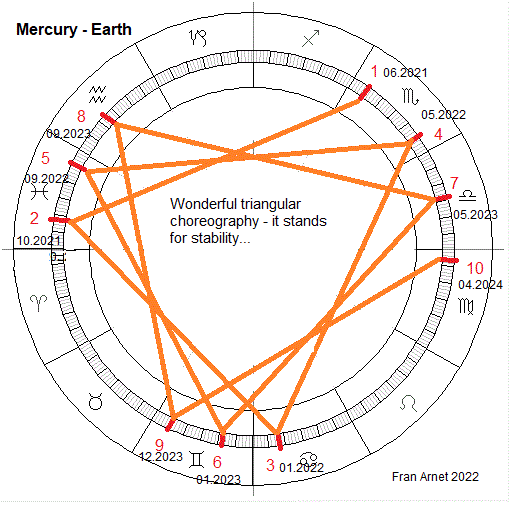Mercury - "The God's Messenger"...
Astrology:
He's about communication from physical to psychic - of course, this includes speech, writing or any other form of communication, the internet, record keeping etc. He's fast, agile, intelligent and mutable. Commerce is another big theme of his and it's said he can be pretty "tricky". Because of his status as a messenger and middle Person, he's also said to be associated with siblings in general (or maybe groups we would call "sister- or brother hood" - he's also good in multitasking, is curious, flexible and embraces the "new". He rules the neurological systems (electric) in our body, which includes our inner "communication", on the physical and non physical level, therefore also about how we think and "talk" to ourselves, aloud or silent...
He can also be linked to "mystic experiences".
Greek Mythology:
Hermes is the son of Zeus and Maia (daughter of the Titan Atlas). From the beginning he was very vivid, loved nature and to play "little games" with Humans and the other Gods (a trickster). His playful creativity did produce the famous Lyra, which he later gave to Apollo. Most of all he was the "Messenger" and also guided the Souls to the gates of Hades. He was often depicted as the god of commerce and travels. He got "feathered" feet and helmet to travel fast and the caduceus (as a symbol of neutrality) to travel without problems. He's also linked to the Egyptian God Thoth (Scribe - record holder) and as that "profession" also been linked to Archangel Metatron.
Some Astronomy:
Its orbit around the Sun takes 87.97 Earth days, the shortest of all the planets in the Solar System. His apparent distance from the Sun (as viewed from Earth) never exceeds 28°. Mercury's axis has the smallest tilt of any of the Solar System's planets (about 1⁄30 degree). Its orbital eccentricity is the largest of all known planets in the Solar System; at perihelion, Mercury's distance from the Sun is only about two-thirds (or 66%) of its distance at aphelion. Mercury is one of four terrestrial planets in our system, and is a rocky body like Earth. It is the smallest planet in the Solar System, with an equatorial radius of 2,439.7 km (1,516.0 mi). - Ref. Wikipedia

"Unmasking Mercury"
NASA/Johns Hopkins University Applied Physics Laboratory/Carnegie Institution of Washington
Mercury's orbit, cycle and resonance
He's a slow "spinner" - he rotates around his own axis in 58.7 Earth days (called a sidereal day or Mercury day). He orbits the Sun once in 87,97 days and got a synod with Earth every 116 days. His Sun-day is 176 Earth-Days. In one Orbit, he rotates 1,5 times and after 2 orbits he faces the Sun from the same side again = 3 : 2 resonance. It's interesting that the Earth-Mercury synodic time is almost 2 rotations of Mercury.....
Credit Illustration of this 3:2 resonance of orbit and rotation:
By Tos, CC BY-SA 3.0, https://commons.wikimedia.org/w/index.php?curid=3505126
Somehow this "diagram" does remind me of some MRI pictures of the brain - I would not be surprised if the position of the Sun in this diagram would mark areas like the pituitary gland and the pineal...

Mercury and Earth relationship - heliocentric sidereal
Mercury meets with Earth on an average of 116 days - yet, that varies where in their orbits they are... See below the Geometry they form with their orbital "dance" - I often call this "choreography":

For more details, and explanation - I created a course...
An introduction video and further link you can find on my
Event-page.... "lifetime" access for ca. $22
some "mechanics" of the Mercury orbital cycle (geocentric view)
Mercury and Venus are orbiting "between" the Sun and Earth and as viewed from Earth we can only see them in a "close" angle to the Sun.
And we see their opposition like a conjunction and because of that there are other terms used to "distinguish" the two events.
When Mercury or Venus are on the other side of the Sun (opposition from Earth) it's called a superior conjunction and when they are in conjunction with Earth it's called an inferior conjunction.
The alignment of the superior conjunction: Mercury - Sun - Earth
The alignment of the inferior conjunction: Sun - Mercury - Earth
When Mercury or Venus are at inferior conjunction they will station and then go "retrograde", station again and directly go over the same longitudes again.
Within the time from inferior to superior conjunction Mercury will appear as the Morning star (rising before the Sun) for some time and from superior to inferior conjunction will set after the Sun as the Evening star for some time - same "mechanics" for Venus.
Mercury is one of the very "personal" planets through his placement closest to the Sun. The inferior conjunction and therefore "new cycle" with Earth is significant and "feelable". The retrograde time does give us the "time-space" to really incorporate all that we experienced in the old cycle - to reflect and discern what is worth to take with us into the new cycle and what is kind of "outdated" and can be dismissed...